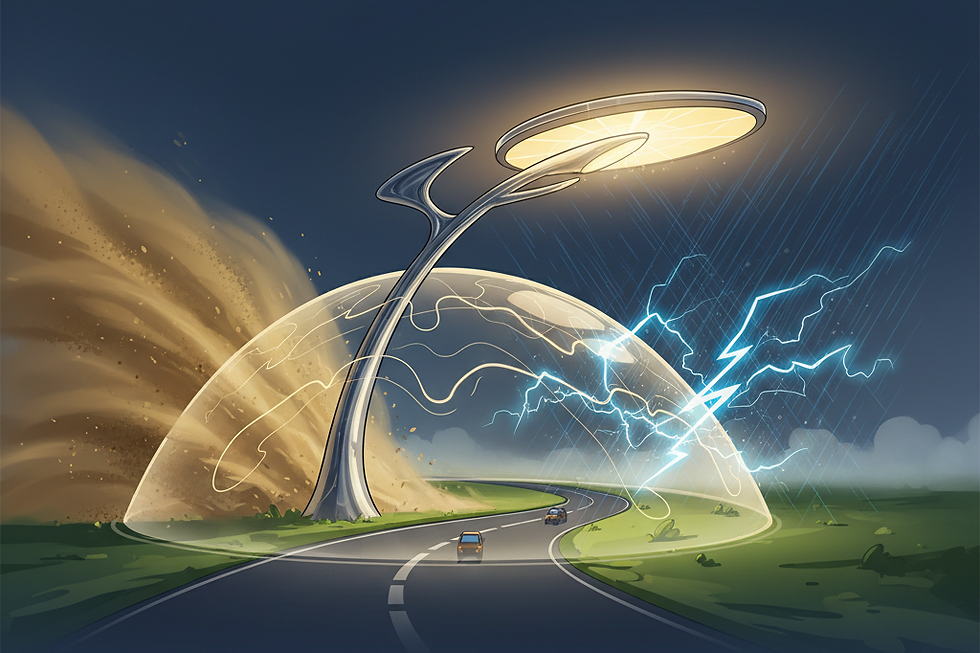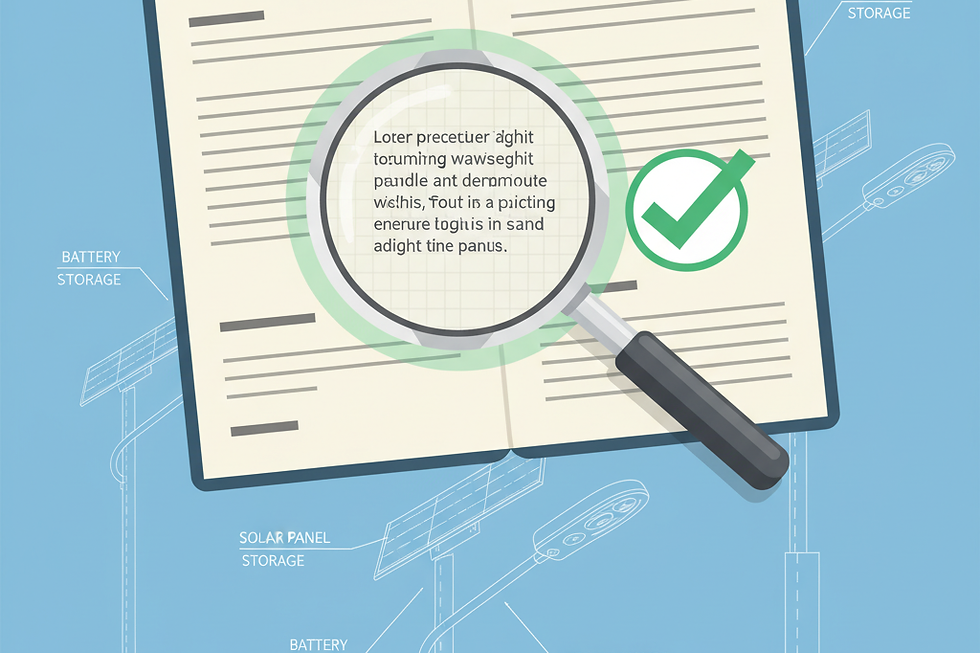China Commercial Solar Street Lights 2025: The Ultimate Guide to Standards & Compliance for Global Procurement
- coco wang
- 9月23日
- 讀畢需時 6 分鐘
An Invisible Line Between Project Success and Failure
For any project manager, government procurement officer, or engineer sourcing commercial solar street lights from China, the landscape can feel like a minefield. You're bombarded with datasheets, competing price points, and a dizzying array of certifications. The most dangerous assumption? Believing that a low price tag or a simple ?CE? stamp is a reliable indicator of quality. This isn't just a minor oversight; it's a strategic error that can lead to premature failures, budget overruns, and significant safety risks.
In the world of global infrastructure, standards and compliance are not bureaucratic checkboxes. They are the fundamental language of trust, safety, and performance. They represent the invisible line between a project that delivers reliable, long-term value and one that becomes a costly, recurring headache. This guide is designed to arm you with the critical knowledge to navigate the complexities of international and Chinese standards, transforming your procurement process from a game of chance into a strategy for success.

The Two Worlds of Standards: Decoding International vs. Chinese Regulations
Understanding the hierarchy and purpose of different standards is the first step toward making an informed decision. Not all certifications are created equal, and knowing which ones to prioritize is crucial for your project's specific needs.
IEC Standards: The Global Baseline for Safety and PerformanceThe International Electrotechnical Commission (IEC) sets the gold standard for luminaires worldwide. For a solar street light, the most critical standard is IEC 60598. This isn't a single test but a comprehensive family of standards covering everything from electrical safety and thermal management to material durability. It ensures the luminaire is fundamentally safe and built to last. For an engineer, demanding a full IEC 60598 test report (not just a certificate of compliance) is non-negotiable as it provides the raw data on the product's construction and safety margins.
CE & RoHS: Your Passport to the European MarketThe CE mark is a declaration by the manufacturer that the product meets the essential requirements of relevant European directives. For lighting, this primarily involves the Low Voltage Directive (LVD) and the Electromagnetic Compatibility (EMC) Directive. It's a mandatory passport for market entry into the EU. Paired with this is the RoHS (Restriction of Hazardous Substances) directive, which restricts the use of specific hazardous materials. For a distributor, a valid CE mark is essential for business, but for a procurement officer, it's crucial to understand it's a self-declaration, making third-party verification all the more important.
IP & IK Ratings: Quantifying a Product's ToughnessThese two codes are a universal language for durability. The IP (Ingress Protection) rating, governed by IEC 60529, measures protection against solids (dust) and liquids (water). A rating like IP66 signifies a product that is dust-tight and can withstand powerful water jets. The IK (Impact Protection) rating, from IEC 62262, measures resistance to mechanical impact. An IK08 rating, for example, ensures the fixture can withstand the impact of a 1.7 kg object dropped from 300mm. For projects in harsh climates or public areas prone to vandalism, these ratings are a direct indicator of the product's survival prospects.
The Certification Myth: Why a Stamp Isn't Always a GuaranteeA critical pitfall many buyers fall into is accepting a certificate at face value. The market is unfortunately rife with misleading or outright fake documentation. A savvy buyer must dig deeper. Does the certificate come from a reputable, accredited laboratory? Does the product model number on the certificate exactly match the product being purchased? Some manufacturers may only certify one component or a single model, then imply that their entire product line is compliant. This is a red flag that can hide significant quality and safety gaps.

Beyond the Certificate: How Standards Dictate Real-World Performance & ROI
Compliance isn't just about avoiding legal trouble; it's a direct predictor of a product's long-term performance and, ultimately, your project's return on investment. A non-compliant product fails faster, costs more to maintain, and performs worse.
The High Cost of Poor Electrical Safety (IEC 60598)A failure to meet IEC 60598 isn't just a theoretical risk. It can manifest as poor insulation that breaks down under UV exposure, leading to short circuits after a year of operation. It can mean inadequate creepage and clearance distances, posing a genuine fire hazard in humid conditions. For a facility manager, this translates into unexpected downtime and expensive emergency repairs. For a municipal project, it's a public safety liability. Rigorous adherence to this standard ensures the product's electrical system is robust enough for a 10+ year operational life.
Durability by Design (IP/IK Ratings): The Shield Against a Costly Early DemiseImagine a solar light installed in a coastal area. Without a high IP rating (IP66 or higher), salt-laden moisture will inevitably penetrate the housing, corroding the electronics within months. Consider a light in a public park. Without a high IK rating (IK08 or higher), a single act of vandalism can shatter the lens, rendering the light useless. These standards are not 'nice-to-haves'; they are essential design criteria that prevent the most common causes of premature field failure, safeguarding your initial investment.
Performance You Can Bank On (Photometric & Efficiency Standards)While standards like IES LM-79 and LM-80 are more U.S.-centric, the principles are universal. Reputable manufacturers must provide reliable photometric data in the form of IES files. This data, when used in lighting design software, proves that the light will meet the required illuminance (lux) levels on the ground. Without this, you are buying a 'lumen' number with no guarantee of how it will perform in reality. This is crucial for project managers who are contractually obligated to meet specific lighting standards (e.g., CJJ 45 for urban roads).

The Procurement Playbook: A Step-by-Step Guide to Verifying Compliance
Shifting from a passive recipient of information to an active investigator is the key to mitigating risk. Here is a simple, effective framework for due diligence.
Step 1: Demand the Full Dossier, Not Just the SummaryNever accept a certificate alone. Always request the complete, multi-page test report from the laboratory. This document contains the technical proof of compliance. A hesitant or unwilling supplier is a major warning sign. The report will detail the exact product configuration tested, the standards applied, and the results of each individual test clause.
Step 2: Authenticate the AuthenticatorNot all labs are created equal. Check if the testing laboratory is accredited by a recognized body (e.g., CNAS, T�V, SGS, Intertek). Most reputable labs have an online database where you can verify the authenticity of a report number. This simple check can instantly expose fraudulent documents and save you from a disastrous procurement decision.
Step 3: Scrutinize the Details?The Devil is in the DatasheetOnce you have the full test report, perform a critical cross-check. Does the product model number, including all suffixes and variations, perfectly match your purchase order? Does the product photo in the report match the supplier's marketing materials? Are the key components listed (e.g., LED driver, LED chips) consistent with what is being offered? Any discrepancy, no matter how small, is a valid reason to ask for clarification or reconsider the supplier.
Conclusion: From Compliance Checkbox to Strategic Advantage
In the global marketplace of 2025, sourcing solar street lights from China offers immense opportunity, but it demands a higher level of diligence. The era of 'trust but verify' is over; the new mantra is 'distrust until verified through data.'
Moving forward, reframe your perspective on standards. They are not a cost to be minimized but an investment to be maximized. By prioritizing suppliers who can provide transparent, verifiable, and comprehensive compliance documentation, you are not just buying a product. You are investing in long-term reliability, public safety, and the financial sustainability of your project. This rigorous, standards-first approach is what separates the most successful projects from the ones that fail before their time.
Navigate the World of Solar Lighting with Confidence
Feeling overwhelmed by technical standards and supplier verification? Let's cut through the noise together. At Novafuture Tech, we believe in transparent, data-driven solutions.
Contact our team for expert guidance on your next project.
Website: www.nfsolar.net
Email: cocowang@novafuture.net
WhatsApp: +8613013537907




留言